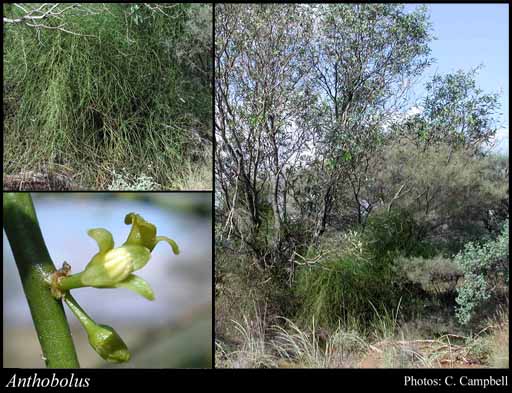- Reference
- Prodr.Fl.Nov.Holland. 357 (1810)
- Name Status
- Current

Scientific Description
Family Santalaceae.
Habit and leaf form. Shrubs; evergreen (when well developed), or deciduous (when scale-like). More or less ‘normal’ plants, or switch-plants; sometimes with the principal photosynthesizing function transferred to stems. Leaves well developed (AKPLB), or much reduced (minute, scale-like), or absent (A). Plants with roots, or rootless; partially parasitic. On roots of the host. Stem internodes solid. Mesophytic, or xerophytic. Leaves alternate; ‘herbaceous’, or leathery, or membranous; sessile; gland-dotted, or not gland-dotted; aromatic, or without marked odour; simple; pulvinate. Leaf blades entire; solid; terete; linear; one-veined, or pinnately veined. Leaves without stipules. Leaf blade margins entire. Leaf anatomy. Hairs absent. Extra-floral nectaries absent. Stem anatomy. Secondary thickening developing from a conventional cambial ring.
Reproductive type, pollination. Fertile flowers functionally male, or functionally female. Unisexual flowers present. Plants dioecious. Female flowers without staminodes. Male flowers without pistillodes.
Inflorescence and flower features. Flowers solitary (female flowers, sometimes), or aggregated in ‘inflorescences’; in racemes, or in umbels, or in fascicles (or clusters). The terminal inflorescence unit cymose, or racemose. Inflorescences axillary; male inflorescence small and usually 3–5 flowered, female inflorescence pedunculate and 1–2 flowered. Flowers pedicellate (prominent for both male and female flowers); bracteate (minute and caducous in female flowers); ebracteolate; small; regular; 3–4 merous, or 3–5 merous; cyclic. Free hypanthium present, or absent; KPB describe floral tube in the Santalaceae but without reference to Anthobolus. Perianth sepaline, or petaline; 3–4 (in male flowers), or 3–5 (in female flowers); 1 -whorled; free, or joined (the lobes valvate); sepaloid, or petaloid; yellow (male flowers), or green to brown (male or female flowers); fleshy, or non-fleshy; persistent, or deciduous. Calyx (‘calycode’) 3–4 (male), or 3–5 (female); 1 -whorled; polysepalous; valvate; regular; green to brown; fleshy, or non-fleshy; persistent, or not persistent. Fertile stamens present, or absent. Androecial members definite in number. Androecium 3–4. Androecial members free of the perianth to adnate (attached at its base); all equal; free of one another; 1 -whorled. Androecium exclusively of fertile stamens. Stamens 3–4; all more or less similar in shape; isomerous with the perianth; oppositisepalous (opposite the perianth segments and near their bases). Anthers dorsifixed, or basifixed; dehiscing via longitudinal slits; introrse; bilocular; tetrasporangiate. Fertile gynoecium present, or absent. Gynoecium (2–)3(–5) carpelled. The pistil 1 celled. Carpels reduced in number relative to the perianth to isomerous with the perianth. Gynoecium syncarpous; synstylovarious, or eu-syncarpous; superior. Ovary unilocular; 1 locular; sessile. Gynoecium non-stylate (AB), or stylate (CL). Styles 1; apical. Stigmas 1; capitate (or lobed). Placentation free central. Ovules differentiated to not differentiated; in the single cavity 1; pendulous; hemianatropous to anatropous.
Fruit and seed features. Fruit fleshy; indehiscent; a drupe, or a nut; 1 celled; 1 seeded. Seeds endospermic. Endosperm oily, or not oily. Seeds without a testa. Cotyledons 2.
Etymology. From the Greek for "flower" and "a throw", as of a fishing net or dice; refers to the early falling of the flowers.
Taxonomic Literature
- Blackall, William E.; Grieve, Brian J. 1988. How to know Western Australian wildflowers : a key to the flora of the extratropical regions of Western Australia. Part I : Dicotyledons (Casuarinaceae to Chenopodiaceae). University of W.A. Press.. [Perth]..